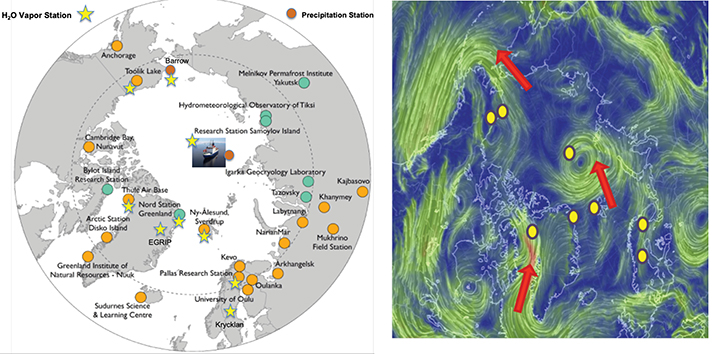AGU 2019 and EGU 2020 abstracts below; AGU poster download available; more information is available on request.
AGU 2019
MOSAiC’s Pan Arctic Water Isotope Network & Discoveries
Welker, Klein, Noone, Bailey, Akers, Kopec, Mustonen, Marttila, Ardakani, Steen-Larsen, Hubbard, Klove
The most advanced and ambitious Arctic research program ever is now underway that is based on a year-long interdisciplinary study of the central Arctic Basin, MOSAiC (Multidisciplinary drifting Observatory for the Study of Arctic Climate-2019-2020). We are using in-situ water vapor isotope measurements on board the icebeaker Polarstern, together with a circum-Arctic land-based network of continuous water vapor and precipitation isotope stations, to resolve the patterns and processes governing the δ18O, δ2H and d-excess values of the Arctic water cycle.

During the control year (2018-2019), we present five primary observations. 1) in NW Greenland water vapor isotopes differ by up to 10 per mil in δ18O when moisture is sourced from the Greenland Ice Sheet compared to N Baffin Bay. 2) In Arctic Finland, four distinct winter moisture sources (North Atlantic, Baltic, Eurasian and Barents) are defined. 3) Parcels that originate over the eastern Arctic ice pack and pass over an open water Barents sea, immediate gain evaporated water at the ice-ocean edge and then deposit water vapor that is enriched compared to moisture that is sourced out of the Eurasian basin with no injection of ocean water evaporate. 4) The 2019 summer Greenland massive ice melt is distinguished isotopically in water vapor measurements at Thule, indicative of excessive surface sublimation and surface pond melt water evaporation. 5) Pan Arctic precipitation isotopes reflect the complexity of summer, spring and winter moisture sources that for Svalbard can originate in the Labrador Sea. These studies are revolutionizing our understanding of the current atmosphere-cryosphere-biosphere interactions and the cycling of water within, into and out of the Arctic. This data is being applied to our modern understanding of the north, providing completely new lenses to reassess ice core records and calibrate Arctic-specific isotope-GCM’s.
Full poster for download: https://mosaic.colorado.edu/sites/default/files/jw_AGU_2019poster.pdf
EGU 2020
MOSAiC’s Pan Arctic Water Isotope Network: Sea ice-water vapor isotope interactions and transport processes within, into and out of the Arctic
Ben Kopec, Eric Klein, David Noone, Hannah Bailey, Kaisa-Riikka Mustonen, Pete Akers, Jean-Louis Bonne, Martin Werner, Hans Christian Steen-Larsen, Franziska Aemisegger, Bjorn Klove, Alun Hubbard, Jeff Welker
Session: CL4.14: Arctic changes – processes and feedbacks in climate, ocean and cryosphere
MOSAiC is a one of a kind, year-long study of the Arctic Basin’s behavior focused in large part on interactions between sea ice, atmospheric processes, ecosystem dynamics and oceanography, as well as connections between the Arctic and the mid-latitudes. Our MOSAiC project is focused on how the Arctic Basin’s water cycle behaves throughout the year, especially now that sea ice loss allows for a new source of moisture to the atmosphere during times when this basin was frozen over. These massive changes in open water and corresponding fluxes in conjunction with significant shifts in atmospheric circulation, are altering how moisture is transported into, within, and out of the Arctic Basin. In order to help quantify these Arctic hydrologic cycle variations, we have established the AWIN (Arctic Water Isotope Network) that uses continuous water vapor isotope measurements (deuterium/hydrogen or δD, 18O/16O or δ18O, and deuterium excess or d where d = δD - 8δ18O) at eight land-based stations from Barrow in Alaska to Ny Alesund in Svalbard, as well as on board the Polarstern.
With a network of sites rather than a single station, we gain the significant advantage of being able to track water vapor and how it varies from site to site, allowing us to identify the sources of moisture, and how and where that moisture is transported into, within, and out of the Arctic. For this analysis, we focus on the first months of the expedition (October-December 2019) to closely examine cases of critical events including a major low-pressure system in mid-November that impacted much of the Arctic Ocean basin and three key repeating transport regimes – 1) transport into the Arctic from the North Atlantic via the Greenland Sea, 2) transport into the Arctic via Baffin Bay, and 3) transport out of the Arctic via the Greenland Sea, as well as transport within the Arctic during each of these regimes. For example, in the scenario of transport into the Arctic via Baffin Bay, at our site in Thule, Greenland, we see significant reductions in deuterium excess each time the southerly flow initiates, suggesting significant moisture evaporating from nearby in Baffin Bay. We then can track that moisture to another site to observe how much of that locally-sourced vapor is transported to a given downwind location, allowing us to quantify vapor fluxes across the Arctic. By examining these scenarios under varying sea ice conditions and large-scale atmospheric circulation patterns, this circum-Arctic network of water isotope measurements is transforming our understanding of the Arctic hydrologic cycle during MOSAiC.<